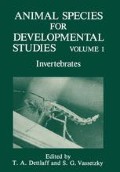Abstract
Since the times of A. Trembley (first half of the 18th Century) (see [7]) freshwater hydra have been used in laboratories as a suitable species for studying the mechanisms of regeneration and asexual reproduction (for a review of earlier papers, see [6]). Since the middle of the 20th Century there have been many detailed investigations on the mechanisms of cell differentiation and the control of morphogenesis. It is impossible to review so much work in his short chapter (for references see [21]). Investigations make use of the adult, intact, regenerating, and budding hydra as well as mutant strains, their chimaeras, and cell cultures.
Access this chapter
Tax calculation will be finalised at checkout
Purchases are for personal use only
Preview
Unable to display preview. Download preview PDF.
References
T. B. Aizenstadt, “Study of oogenesis in the hydra. 1. The ultrastructure of interstitial cells at different stages of their transformation into oocytes,” Ontogenez 5, 18–30 (1974).
L. V. Belousov, L. A. Badenko, A. L. Katchurin, and L. F. Kurilo, “Cell movements in morphogenesis of hydroid polyps,” J. EmbryoL Exp. Morphol. 27, 317 (1972).
S. Crowell and M. Rusk, “Growth of Campanularia colonies” Biol. Bull. 99, 357 (1950).
J. Davidson, “Hydra hymanae: regulation of the life cycle by time and temperature,” Science 194, 618 (1976).
M. H. Gruzova, “New data concerning Hydra vulgaris (Pall.) development,” Dokl. Akad. Nauk SSSR 109, 670 (1956).
I.I. Kanayev, The Hydra. Essays on the Biology of the Freshwater Polyps [Bin Russian], Nauka, Moscow-Leningrad (1952).
I.I. Kanayev, Abraham Trembley [Bin Russian], Nauka, Leningrad (1972).
W. Kemmer and H. C. Schaller, “Analysis of morphogenetic mutants of Hydrai” Wilhelm Roux’s Arch. Dev. Biol. 190, 191 (1981).
Yu. A. Labas, L. V. Belousov, L. A. Badenko, and V. N. Letunov, “Concerning pulsating growth in multicellular organisms,” Dokl. Akad. Nauk SSSR 257, 1247–1250 (1981).
H. M. Lenhoff (ed.), Hydra: Research Methods, Plenum Press, New York-London (1983).
W. F. Loomis, “Cultivation of Hydra under controlled conditions,” Science 117, 565–566 (1953).
W. F. Loomis, “Sexual differentiation in Hydra: control by carbon dioxide tension,” Science 126, 753–759 (1957).
W. F. Loomis and H. M. Lenhoff, “Growth and sexual differentiation of Hydra in mass culture,” J. Exp. Zool. 132, 555–573 (1956).
D. V. Naumov, Hydroids and Hydromedusae [Bin Russian], Nauka, Moscow-Leningrad (1960).
J. J. Otto and R. D. Campbell, “Budding in Hydra attenuata: Bud stages and fate map,” J. Exp. Zool. 200, 417–428 (1977).
D. I. Rubin and H. R. Bode, “The aberrant, a morphological mutant of Hydra attenuata, has altered inhibition properties,” Dev. Biol. 89, 316 (1982).
A. R. D. Stebbing, “Hormesis-stimulation of colony growth in Campanularia flexuosa (Hydrozoa) by copper, cadmium, and other toxicants,” Aquat. Tox. 1, 227–238 (1981).
P. Tardent, “Zur Sexualbiologie von Hydra attenuata,” Rev. Suisse Zool. 73, 357–381 (1966).
P. Tardent, “Experiments about sex determination in the Hydra attenuata Pall,” Dev. Biol. 17, 483–511 (1967).
P. Tardent, “Coelenterata, Cnidaria,” in: Morphogenese der Tiere, F. Seidel (ed.), Lieferung I: A–I, 68–415, VEB Gustav Fisher Verlag, Jena (1978).
P. Tardent and R. Tardent (eds.), Developmental and Cellular Biology of Coelenterates, Elsevier/North–Holland Biomedical Press, Amsterdam-New York-Oxford (1980).
P. Tardent, “The differentiation of germ cells in Cnidaria,” in: The Origin and Evolution of Sex, Alan R. Liss, Inc., New York (1985).
J. Zihler, “Zur Gametogenese und Befruchtungsbiologie von Hydra” Wilhelm Roux’s Arch. Entwicklungsmech. Org. 169, 239–267 (1972).
Editor information
Editors and Affiliations
Rights and permissions
Copyright information
© 1990 Consultants Bureau, New York
About this chapter
Cite this chapter
Belousov, L.V. (1990). Hydra and Hydroid Polyps. In: Dettlaff, T.A., Vassetzky, S.G. (eds) Animal Species for Developmental Studies. Springer, Boston, MA. https://doi.org/10.1007/978-1-4613-0503-3_3
Download citation
DOI: https://doi.org/10.1007/978-1-4613-0503-3_3
Publisher Name: Springer, Boston, MA
Print ISBN: 978-1-4612-7839-9
Online ISBN: 978-1-4613-0503-3
eBook Packages: Springer Book Archive

